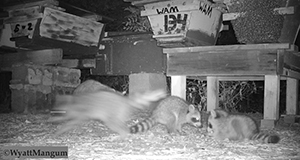
We see very little of what occurs in our apiaries. During hive inspections, we glimpse some of the inner workings of the colonies. Around our hives, we do not see much either. At night, we witness even less.
All of my apiaries are at rural locations. Two apiaries are even by wildlife trails, upping the critter traffic, in addition to the variety of them. Night brings numerous small animals to my apiaries, scavenging for dead bees. Or maybe they just pass through as chance encounters. How do I know? Game cameras.
Although game cameras do not record everything, they can photograph wildlife coming around hives. These motion-activated cameras take pictures day and night, which could be just heavy rain or the wind moving vegetation to a sprinting coyote running through the apiary. While game cameras are typically used to photograph large animals like deer and bears out in a field, I use them for smaller critters in the apiary like possums, even mice.
With game cameras in all of my apiaries, I had accumulated over 60,000 photographs by the time I published my book Top-Bar Hive Beekeeping: Wisdom and Pleasure Combined (in 2012). From all those thousands of photographs, hundreds were good. From them, several were exceptional. I put about a dozen game camera pictures in the book. Of course that left a slew of others, just as compelling, stored away where hardly anyone could see them. So let’s enjoy another selection of pictures, each coming with its own story. There is no telling what we will learn along the way. I also include some technical comments for beekeepers wanting to explore game camera use in their apiaries.
Beginning in the daytime, one of my favorite photographs is a stern-looking hawk before a row of top-bar hives (see Figure 1). From the series of photographs shot moments before this one, apparently the hawk had just flown down and pounced on something in the grass. While the camera reset itself, the hawk flew off. So far the hawk has appeared only once on camera, although I see them patrolling around my apiaries.
Another chance encounter had a fawn appearing startled by buzzing from my hives. Anticipating smaller animals, low on the ground, I had the camera aiming downward, using the entrances of Hive 44 in the top of the picture. The fawn is a little taller. While the photograph did not include the top of the little deer’s head, you can tell the bees have captured the creature’s attention (see Figure 2). I have other deer pictures, which are like the common pictures seen with these cameras, but not one with a little fawn, or rather most of one.
For the next picture, a wildlife trail ran though this apiary and led to a break in the wood line by the hives. Except for the break, a thick border of brush overgrew an old wire fence separating an old-growth forest from the adjacent farm field. The trail tended to funnel wildlife through the apiary. Occasionally wild turkeys passed by, typically hens with their young. Their rapid twitchy movements usually came out as blurs in the pictures, except for this one (see Figure 3).
At night, game cameras photograph with infrared light, a light invisible to us and to various animals (an assumption). The camera converts the infrared light into the shades of gray seen in the pictures. Infrared light is a better illumination compared to a burst of white (visible) light from a typical camera with a flash. That would startle a nocturnal animal.
However, the camera can set off a big burst of infrared light to illuminate deer out in a field, a typical use. With the camera in a more confined apiary, that could be too much light, causing overexposed photographs. Like its visible light counterpart, over exposure with infrared light is a washed-out place on the picture; too much can ruin the entire image. I set back the camera from vegetation, tree trunks, hives, etc. Also reflective glare comes from the animals too. For example, generally, foxes are more reflective than skunks. So near the camera, a fox (red or gray in my area) might give too much glare, but a black skunk would not.
(When using game cameras for apiary surveillance concerning hive theft, I set back the cameras farther to see more hives, including my bee truck to make sure a vehicle fits in the pictures. So far as I have seen, license plates are extremely reflective in infrared light. The plates reproduce as white blanks, providing no information. I wonder though, if the flash were weak (from low batteries or by covering some of the flash unit on the camera), the license plate information might show through the remaining glare off the plate.)
Once I saw drag marks through one of my apiaries way out in the woods. The marks were multiple little parallel grooves in the dirt, going toward the creek line in one direction. I tracked the marks in the other direction. They led to a mid-size tree, fallen to the ground, gnawed off at the stump. Nearby other tree trunks were partly chewed. I knew the loggers at this job site –– beavers. They were cutting off the smaller limbs from ….


